In today’s digital world, every customer is only a few clicks away from their next fashion purchase. Email marketing enables fashion brands to get their latest styles into their minds, inboxes, and ultimately the closets of their customers. This guide is offered to illustrate the distinction between email types, what you need to make sure you adopt and help appreciate why hyper-personalisation solutions are essential to the mix.
With every $1 spent on email marketing generating a $38 return from a report by our very good friend Jordie van Rijn – it’s no surprise that the top ecommerce fashion stores are focusing their efforts on email marketing. But fashion email marketing is no longer “This Month’s Top Picks” sent to your entire subscriber list. A successful fashion email marketing strategy includes campaigns that are personalised, triggered, and automated.
We’ve put together 12 different emails that every ecommerce fashion store needs to send. While 12 email campaigns might seem like a lot to be sending, most are automated, and you’ll start to see more sales by only implementing a third of the suggested emails into your fashion store’s marketing strategy. If you’re on Shopify, Magento, WooCommerce etc – you can integrate email marketing apps to start sending fashionable emails in minutes.
1. Welcome Email
Your fashion welcome email is your chance to make a good first impression – don’t be lazy. The average welcome email generates four times the total open rates and five times the click rates compared with other bulk promotions. More importantly, revenue per email is eight times higher and transaction rates are nine times higher. But you won’t cash in on this sales opportunity with a black-and-white confirmation email.
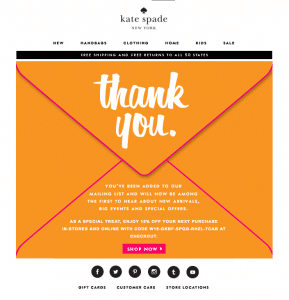
When designing your welcome email include:
- A sincere thank you
- Creative imagery
- Content associated with your brand
- Links to your social profiles
The majority of ecommerce fashion stores also email a 10-20% discount to entice subscribers to make their first purchase from the store.
2. Content Email
Sadly the first thing many ecommerce fashion retailers do is start hard-selling their products right away. The result is a boring brand and an endless stream of apparel that your customer knows nothing about.
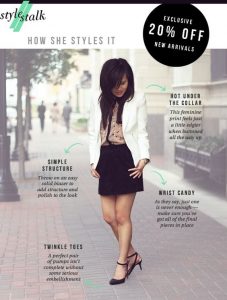
Luckily as a fashion retailer, you have a wealth of content options you can send your subscribers. Use your content newsletter to promote your brand, educate your customers on the latest styles, and entertain them with meaningful content. You can get started with these 3 examples from leading fashion brands:

Email 1: Tell Your Story
Let your customers get to know you before they purchase from your store. Tell your brand’s story, including why you sell your products and who you sell them to. While not strictly a fashion or apparel retailer, no one can deny that Huckberry are master of email marketing. Their email does a great job of telling their story, while still including some products from their store.
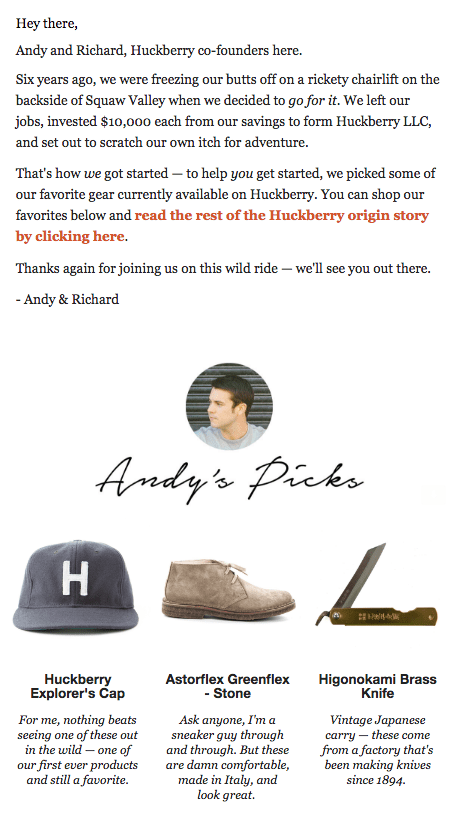
Email 2: Style Tips
Emailing products that your customers don’t know how to wear is pointless in fashion marketing. Use your content email to educate your subscribers on the latest styles and how to wear certain items. If you have an accompanying bricks-and-mortar store, get your staff involved in blogs where they share how they wear their favourite items. Banana Republic includes helpful style tips when they launch new collections.
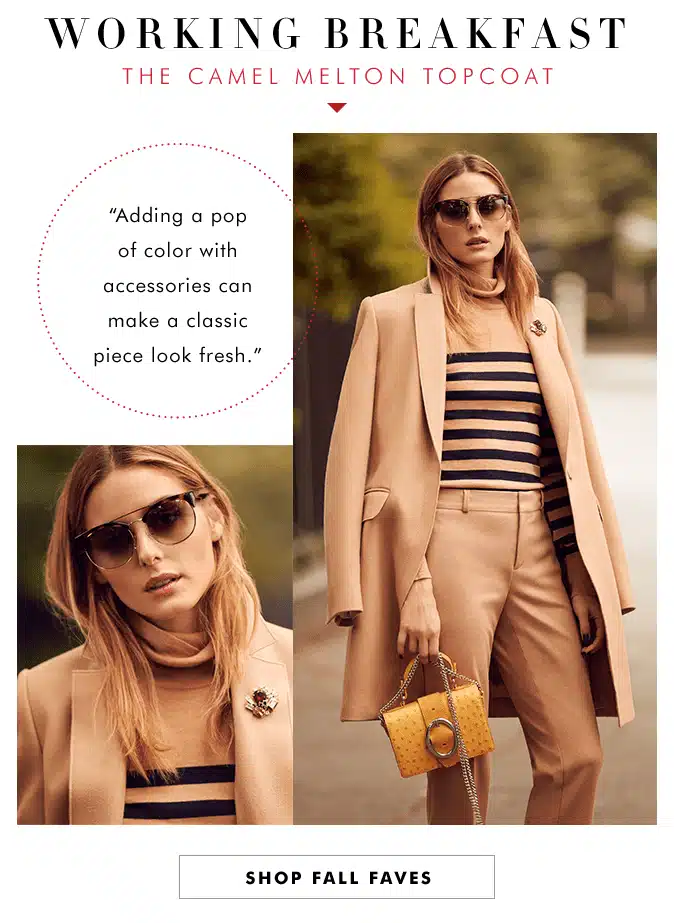
Email 3: Guest Blog Feature
You no longer need a celebrity to wear your products for ecommerce fashion success. Partner with a local fashion blogger or influencer to create a blog post on your website. Get them to write on how they create their favourite outfits and put together a collection of related items. Share the blog post via email to nurture your leads and provide a fresh dose of content.
Check out Urban Outfitters’ guest blog with surfing influencer, Mick Rodgers.
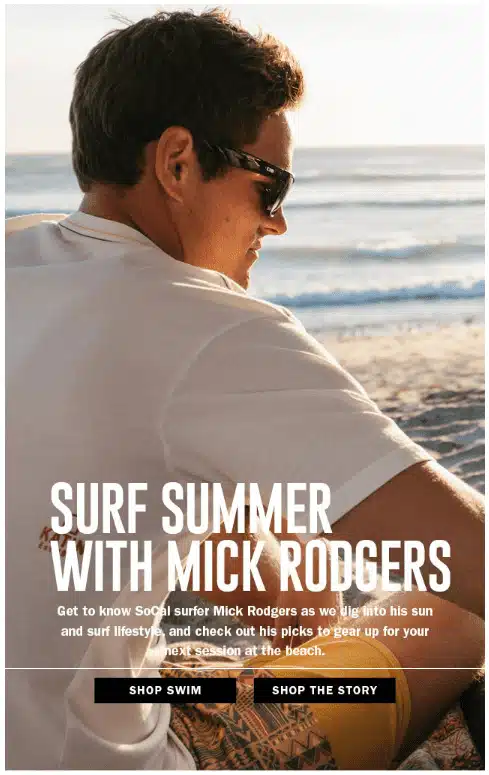
Depending on the size of your store and the capabilities of your marketing team, schedule content emails once to twice a month as you don’t want to overfill your subscribers’ inboxes.
3. Promotional Email
Now that you’ve given your subscribers a warm welcome with thank yous, branding, and content – it’s time to run your first sales campaign. The best channel to do this is email.
When it comes to purchases made as a result of receiving a marketing message, email has the highest conversion rate (66%), beating out social, direct mail and more.
The first step of any promotional email is picking your offer. If you’re putting specific products on sale, segment your list so the right offer gets to the right customers. Don’t forget to flex your creative muscles, as your only goal shouldn’t be to get more sales. You can start with these 3 goal examples…
1. Increase average order value: A generic 20% discount might get you more sales but it also cuts into your bottom line. Add a minimum threshold that customers need to receive the discount. This will get you more sales while also increasing your average order value.
2. Get rid off overstocked or old items: Your stock room might be filled with sunglasses that didn’t sell over summer, but your customers don’t need to know that. Give them away for free for customers who spend a certain amount.
3. Encourage repeat purchases: Instead of offering a discount, give away loyalty points instead. On average, 40% of an ecommerce store’s sales are generated by only 8% of their customers.
The next step is to create your email.
Don’t overfill your promotion email with products, one of the purposes of this email is to drive customers back to your site so they can shop. The data collected from their browsing behaviour can be used to power your product recommendation emails (which we’ll get to next). Make your offer clear, have a clear call to action button to drive traffic to your site, and include a few products related to the sale.
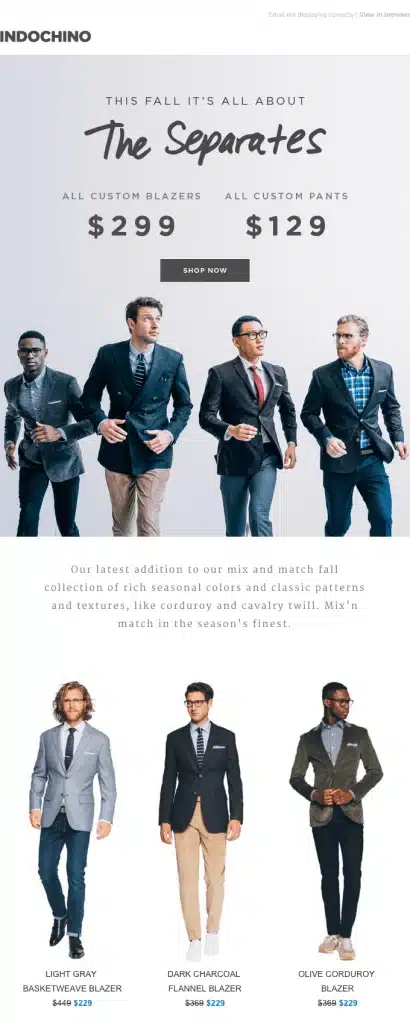
Now it’s time to send your email….
And send it again. and again. We can’t stress enough to SEND MORE THAN ONE EMAIL. People are too busy and inboxes are too full for a single email to grab anyone’s attention. Average ecommerce open rates are only 17.68 per cent, making your time perfecting your campaign worthless if you’re only sending it once. By counting down your sales in your subject lines, you create urgency and increase the chance that your customer opens your marketing message.
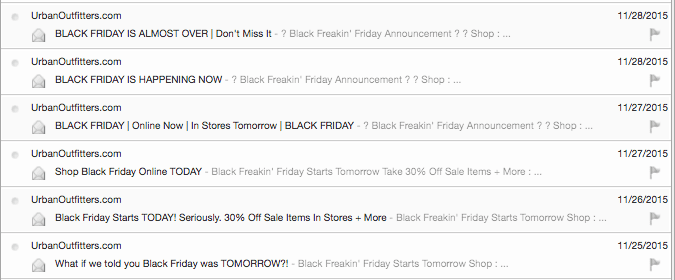
If you think it’s too much work and you’d rather do social, consider this: Only 2% of your Facebook fans will see your post in their newsfeed, while 90% of emails will be delivered to the intended recipient’s inbox.
4. Hyper-personalised Product Recommendations
Do you know the recommended products you see when on a fashion product page? Now, these product recommendations can be emailed as well.
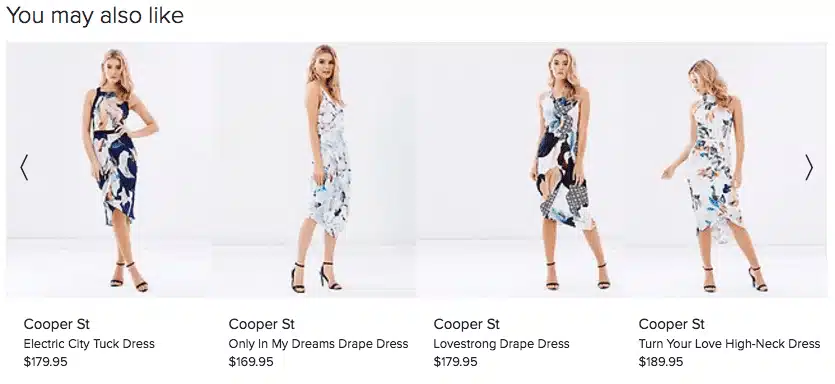
But don’t send the same selection of dresses to everyone. Hyper-personalised emails deliver 6x higher transaction rates compared to bulk email newsletters. Shopify and Magento email marketing apps make it easy to track your customer’s past purchase history, browsing behaviour, and email clicks to power hyper-personalized product recommendations straight into your customers’ inboxes.
It’s all about algorithms
With the myriads of data up for grabs, you can configure the algorithms that serve best your consumer personalisation. They determine what content and product recommendations you provide. You can begin by creating simple recommendations.
You can base these on general trends like the most frequently viewed page within a specific period or recommend items based on the purchase histories, as per SwiftERM, impressions, frequency, patterns, repetition, recurrence, sequence visited – the list is enormous – all captured.
If you want to have an audience stay on your site longer, view the specific offer and come back for more, you need complex algorithms. Take for example Netflix’s favourite collaborative filtering technique, it allows you to foresee users’ interests by combining preferences from many users and comparing them.
Simply put, based on the visitor’s opinion of one item, they’re grouped with other users with similar tastes. The algorithm then recommends items by comparing the visitors’ tastes to others in a given group. Hyper-personalisation solutions identify consumers’ future behaviour ranking every SKU by the greatest likelihood of that individual consumer to purchase, and present it to that individual at exactly the right moment, thereby maximising that individual’s customer lifetime value CLV potential. (i.e. Likelihood to Purchase, Discount Affinity, Likelihood to Churn).
Let us be explicitly clear here, the future of ecommerce is hyper-personalisation which has been established to achieve approximately 26x more than all the other elements listed here combined. So to not include this one, single element, in your mix is equivalent to handing your competitors free reign.
It might sound creepy but your customers want you to do this. 73 per cent of consumers prefer to do business with online retailers who use personal information to make their shopping experience more relevant. If I’m consistently shopping for shoes on your site, I don’t want an email filled with hats.
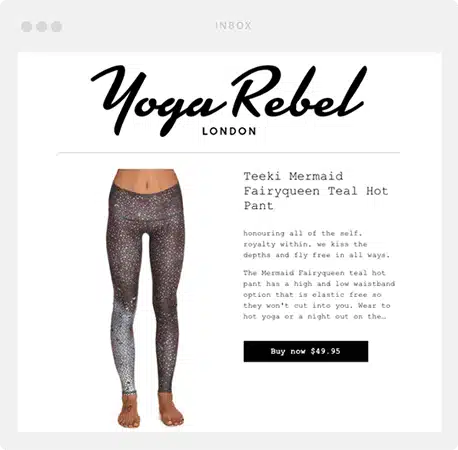
S
end your personalised product emails every week or two to keep your subscribers engaged and one click away from their next purchase. You only have to set up and design them once, giving you time to plan and perfect your promotional email campaigns.
5. Abandoned Cart Emails
Shopping cart abandonment alone accounts for $18 billion in lost revenue for ecommerce companies. Can you imagine what $18 billion of t-shirts, dresses, and other fashion apparel would look like in those carts?
By sending abandoned cart emails, fashion retailers have a chance at converting over 68 per cent of customers abandoning carts on their sites.
Radley London, a fashion accessory brand, recovered 7.9% of lost sales after sending cart abandonment emails. Now let’s say your store brings in $1 million in revenue through the one-third of customers who aren’t abandoning their carts. If you recover 7.9% of the two-thirds abandoned carts, you generate an extra $158,000 in revenue for your fashion store.
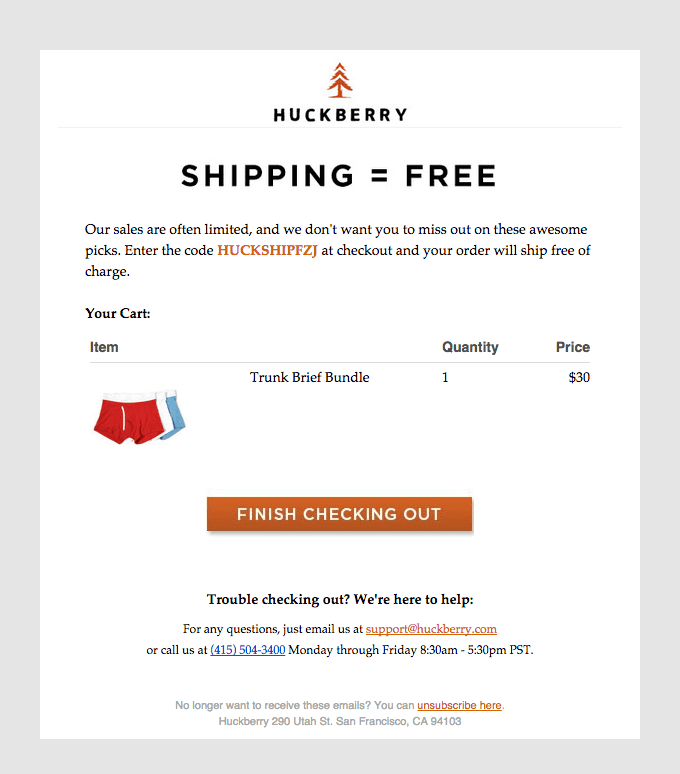
To craft the perfect abandoned cart email, fashion stores must understand what causes cart abandonment in the first place. According to a UPS and comScore study, the top 5 reasons why customers abandon their online shopping carts are unexpected shipping costs or conditions at checkout:
- Browsing for a better price elsewhere
- Didn’t want to create an account to purchase
- The preferred payment was not offered
- Got distracted and forgot to complete the order
Now, let’s use these insights to recover our lost sales.
Firstly, your customer probably isn’t expecting a reminder email, so your subject line should indicate what your email is about. Knowing that your customer likely left their cart due to the costs of the shipping or to find a better price elsewhere, offer free shipping or a small discount to sweeten the deal.
72 per cent of customers who buy from abandoned cart emails convert within the first 24 hours – so set your email to send quickly. If your customer doesn’t convert, send it again and again. Throughout 3 emails create urgency by holding the item in their cart for a set time or by noting how many items are left in stock.

If you want to supercharge your abandoned cart emails, add a few personalized product recommendations. These recommendations can bring your customers back to your site in case they fall out of love with the original product, or if they need to meet a minimum threshold for free shipping.
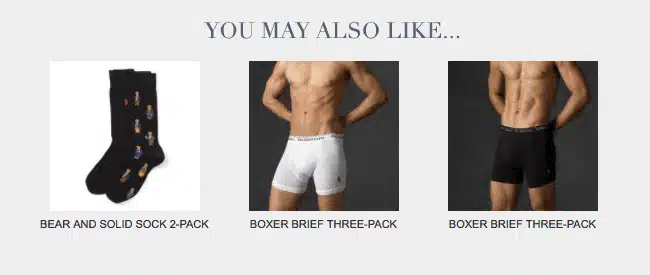
Lastly, no one likes a nag. Use witty copy and fun images to give your customers a laugh and drive them back to their carts.
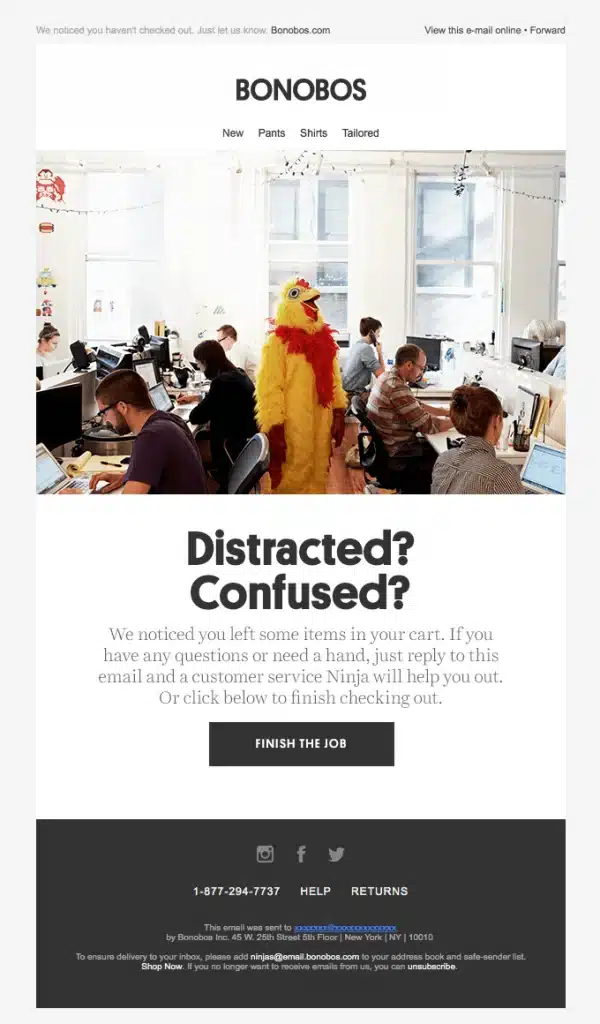
6. New Inventory
With the cost of acquiring new customers continuing to rise, ecommerce fashion stores must shift more focus on engaging their current customers. After all, it costs 5 times more to acquire new customers than it does to keep your existing ones.
Fashion stores can do this by regularly notifying their customers of new items and inventory.
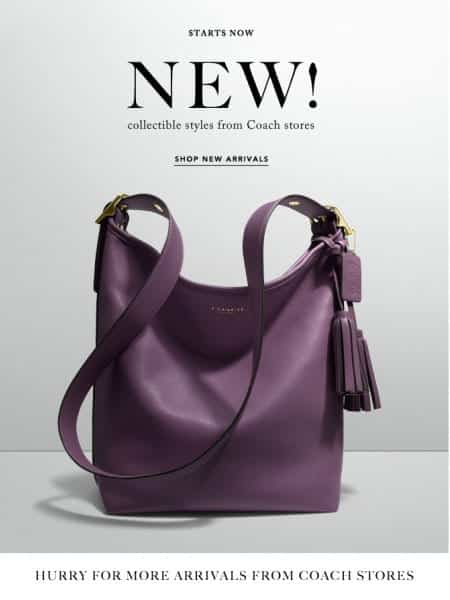
When sending a new inventory email, fashion marketers must keep their email focused. Don’t overcrowd your email with information not relevant to the new inventory. The only goal of this email is to drive customers back to your site to check out your new inventory and ultimately make a purchase.
Some other best practices include:
- Include a few professional product photos: Adding a few of your best items to the email motivates customers to browse the entire range of new items.
- Have a clear subject line: This email doesn’t require a lot of text. However, the text you choose for your subject line will affect your open rates. Keep it simple and indicate what the email is about.
- Segment your email list: Your new selection of summer dresses won’t get much interest from your male subscribers. Send your new inventory email to subscribers who have previously purchased or browsed similar items. Doing so will improve your open rate, clicks, and revenue per email.
- Link to a relevant collection: Link to a separate collection of your new items on your Shopify or BigCommerce store. Don’t send your subscribers to your home page and hope they find their way.
7. Post Purchase Email
Post-purchase email receipts have an open rate of 70.90%, compared to an average email marketing open rate of 17.68%.
Fashion email marketers should use this marketing opportunity to offer discounts, cross-sell, and promote their social channels. The probability of selling to an existing customer is 60-70%, while the probability of selling to a new prospect is 5-20%. Amazon reported that 35% of its revenue is through cross-sales and up-selling efforts, mostly through receipt emails.
Reassuring customers of their purchases also plays a part, called cognitive resonance, this article might be worth your attention.
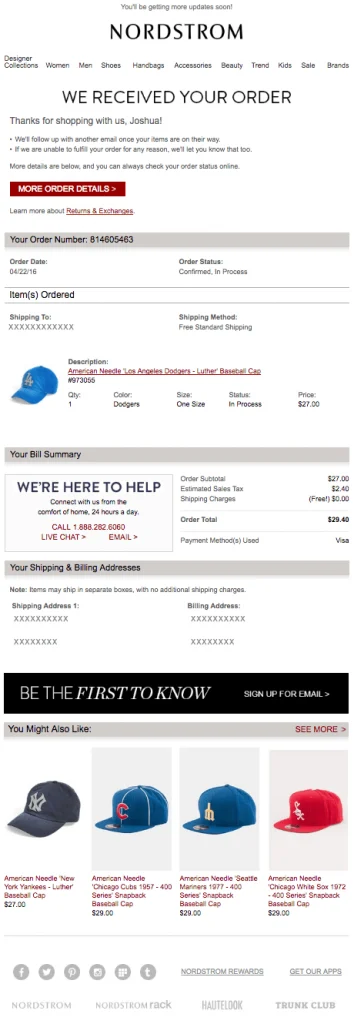
Here are some examples of what you could include in your post-purchase email:
- Post-purchase survey
- Coupon code for next purchase
- Referral code
- Cross-sell product recommendations
- Links to social profiles
- Link to share purchase on social media
If you have a Shopify or BigCommerce store, try out Receiptful for customisable confirmation emails.
8. Review Request Email
Consumer product reviews are 12x more trusted than product descriptions that come from manufacturers and store owners. The content you generate from reviews can be used as social proof on your site and in future promotional emails. Customer-generated content is also great for your SEO rankings as you’ll easily be able to add keywords that differentiate from the standard manufacturer description used by other fashion stores selling similar products.
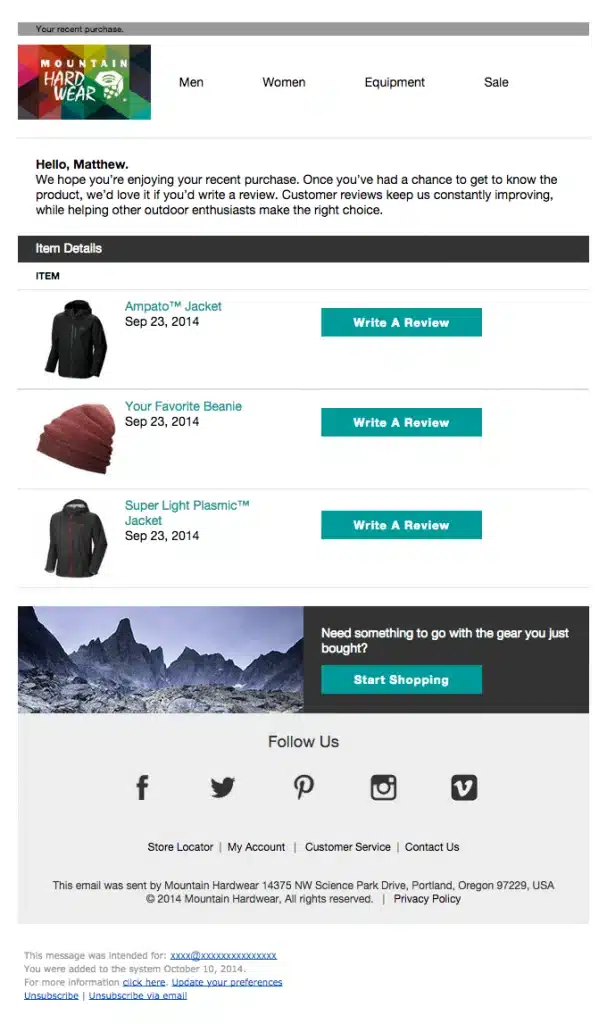
Send your product review request email 2-3 days after you expect your customer to receive their items – keeping their purchase fresh in their mind and giving them a chance to assess the quality of the products.
You should be using Yotpo for this. Their app allows you to send review requests via email, display them on your site, and distribute the content on your social channels.

9. Testimonial Email
Now that you’ve collected great product reviews, start emailing them. 88% of customers trust online reviews as much as personal recommendations and 72% will only take action once reading a positive review.
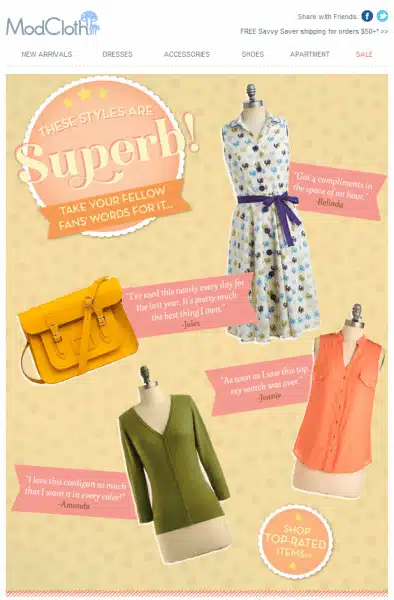
When designing testimonial emails, ensure that the text and product images are clear. Link each product review to a product page where customers can see more reviews of the product.
10. Reactivation Email
Over time your subscribers will begin to tune out of your emails. They’ll stop opening emails, clicking on your site, and buying your products. Don’t make saying goodbye so easy.
Automate a re-engagement campaign that reengages and reactivates dormant subscribers after 60 days. While your main goal is to make more sales, opens and clicks you get from your re-engagement email also signals to Gmail and other ESPs that your customers still love getting emails from you. If a large portion of your email list remains inactive your emails will start ending up in the Promotions tab, and eventually – the deadly SPAM folder.
Read more tips for ecommerce stores to avoid the SPAM folder
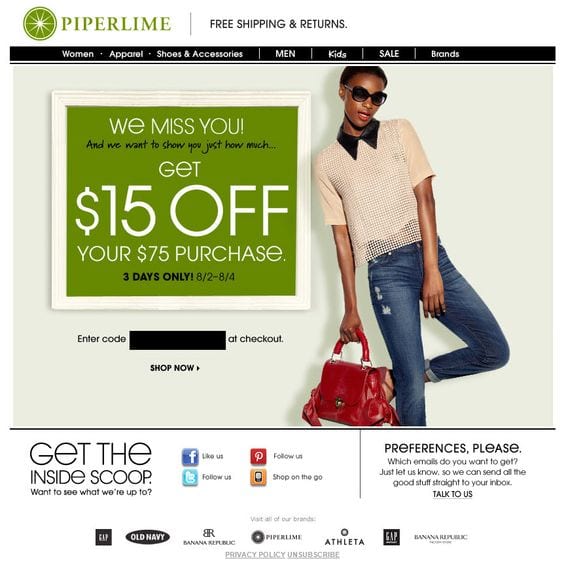
Like other promotional emails, sending it once won’t get you results. Implement this series of 4 re-engagement emails into your fashion email marketing strategy now.
Email 1: “We’ve missed you”
Include a sad face in your body text to create sympathy, and add products based on past purchases and popularity. You can choose to offer a small discount here to further incentives for visiting your site.
Email 2: “50% OFF EVERYTHING – JUST FOR YOU”
Offer a massive discount that they can’t refuse. Be prepared not to make any money from this sale. However, you can leverage the data from their purchase and browsing behaviour to deliver more personalized product recommendations in the future.
Email 3: “You will be deleted from our list in 7 days”
If you’re still not getting any response after that massive offer, it’s time to think about letting go. Notify your subscribers that they will be removed from your list in 7 days and that the offer will soon expire.
Email 4: “You’ve been unsubscribed”
Continuing to email inactive subscribers will lead to your emails being flagged as SPAM. Say your final goodbye to your inactive subscribers, but include a link for them to resubscribe to your email list and reactivate your offer.
11. Holiday Email
On Black Friday in 2015, email marketing drove the most ecommerce sales at 25.1% – more than both social and search.
Considering the creative and sales potential in holiday events, keep your fashion store’s email marketing a step ahead of the competition. Based on your target market, add important events such as Back-to-School, Halloween, Christmas, and Black Friday to your content calendar.

If you’re looking to get started, these are 12 ecommerce holidays that you should build fashion email content around:
- Valentine’s Day – February 14th
- Mother’s Day – May 10th
- Father’s Day – June 21st
- Independence Day – July 4th
- Back-to-School – September 1st
- Labor Day – September 7th
- Halloween – October 31st
- Black Friday – November 27th
- Cyber Monday – November 30th
- Super Saturday – December 19th
- Christmas – December 25th
- Boxing Day – December 26th
Once again! Send more than one email. Counting down your holiday sale will a sense of urgency with your subscribers and encourage them to act quickly.

12. Birthday Email
With personalized birthday emails having 5x the transaction rate of standard bulk mailings, your subscribers aren’t the only ones getting a reward on their birthday.
While the goal of this email is to make a sale on your site, appreciate your active subscribers by giving them a substantial discount. An Experian study found that giving a ‘$X off’ gift had the highest transaction rate and revenue per email when compared to other percentage-based, point-based, or free shipping gifts.
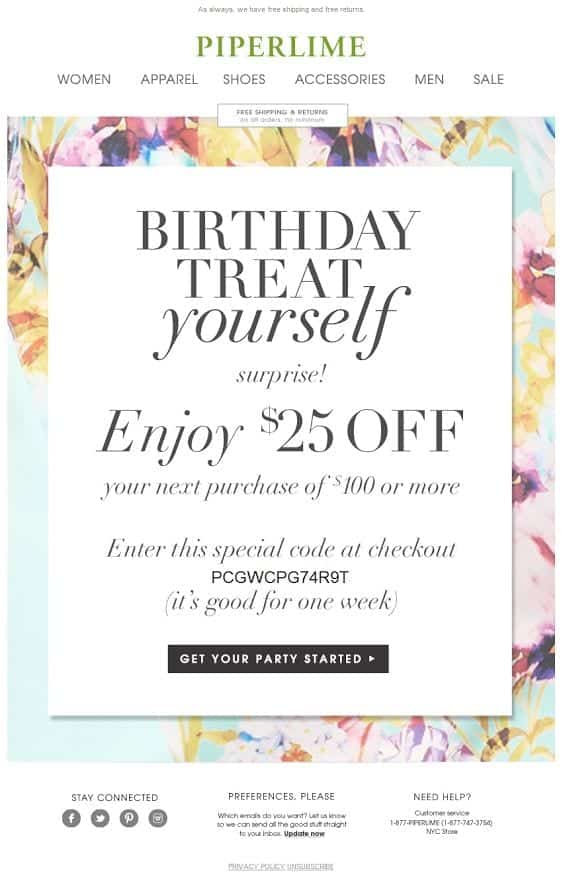
If you’ve made it this far, you’re ready to implement your fashion email marketing strategy. We’ve put together a handy checklist for you to put this guide into action.
Hyper-personalisation Software
Since the advent of AI, autonomous, machine learning hyper-personalisation has taken the fashion industry by storm. Exactly like the cars of the future will be, your email marketing can be left to run itself. When your business is gathering momentum, and you begin to appreciate the value of email marketing, you commonly fall into the pit of affording staff. We published an article to help you calculate how much your staff really cost.
You need to be able to check in on your hyper-personalisation solution from time to time, to satisfy yourself that it is both running and indeed working well. Once established it’s great just to be able to enjoy building your business knowing this is perpetually running in the background without human involvement or issue. Take your days off with your friends and family, enjoy your holidays and spend your time and effort on other aspects of the business where and when it is needed. This is one box that is now ticked.
Within minutes you can automatically have regular hyper-personalised product emails sent, selected for each consumer, and abandon-cart emails.
What’re you waiting for? Start getting more sales for your fashion store now!





